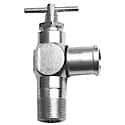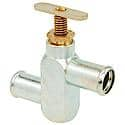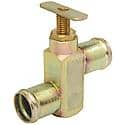Why would the PO put this in the car?
-
brian
- Posts: 6
- Joined: Fri Oct 04, 2019 12:28 am
- Your car is a: 1979 Fiat Spider 2000
Why would the PO put this in the car?
I was getting ready to install a Flush Tee on my car the other day. When I looked at the heater hose for the Tee there was a small valve installed where the Tee would go. The valve had a small T handle that looked like it should open and close the valve. When I tried to turn the handle it was frozen. I removed the valve and installed the Flush Tee in its place. Does anyone have an idea as to why this valve was there in the first place? It looked like the coolant had been shut off to the heater core at that valve. When I took it off there was still coolant in the hose that went to the heater core so it seems that the core is not leaking. Any way any ideas why this thing was there?
-
rridge
- Posts: 162
- Joined: Thu Aug 10, 2006 11:59 am
- Your car is a: 1981 Turbo Spider
Re: Why would the PO put this in the car?
The valve you removed is a seasonal shut-off valve that some owners add. It has two functions, first it cuts off residual heater core heat during the summer. Many heater control valves allow a small flow in the closed position even when the control cable is properly adjusted.
Second, a seasonal valve reduces the chances of a leak into the passenger footwell. The heater control valve is a known weak point in the cooling system with a very finite life. When it fails it can dump hot coolant into the passenger footwell and onto the passenger's feet and legs.
The hose coming off the back of the head is the high pressure supply to the heater. The other heater core hose is the return line to the suction side of the water pump. When the flow is cut by a valve at the head, the pressure on the main control valve is removed.
Second, a seasonal valve reduces the chances of a leak into the passenger footwell. The heater control valve is a known weak point in the cooling system with a very finite life. When it fails it can dump hot coolant into the passenger footwell and onto the passenger's feet and legs.
The hose coming off the back of the head is the high pressure supply to the heater. The other heater core hose is the return line to the suction side of the water pump. When the flow is cut by a valve at the head, the pressure on the main control valve is removed.
-
DieselSpider
- Posts: 2130
- Joined: Wed Dec 24, 2014 10:21 pm
- Your car is a: 1978 124 Spider with Isuzu Turbo Diesel
Re: Why would the PO put this in the car?
Yes, its a safety device and can make summer driving in a car without air conditioning much more tolerable. In my car the previous owner went one step further and looped the flow past the heater and into the return line.
-
brian
- Posts: 6
- Joined: Fri Oct 04, 2019 12:28 am
- Your car is a: 1979 Fiat Spider 2000
Re: Why would the PO put this in the car?
Thanks for the feedback I just could not figure it out. Now it makes sense.
-
spiderman1
- Posts: 123
- Joined: Thu Nov 27, 2014 7:47 am
- Your car is a: 1982 Fiat Spider
- Location: Greensboro, NC
Re: Why would the PO put this in the car?
I would love to see a picture of this seasonal valve. I hope to do that next summer because of the heat. I do have a "T" already installed
-
DieselSpider
- Posts: 2130
- Joined: Wed Dec 24, 2014 10:21 pm
- Your car is a: 1978 124 Spider with Isuzu Turbo Diesel
Re: Why would the PO put this in the car?
Its just going to be a non-bypass shutoff similar to one of these:spiderman1 wrote:I would love to see a picture of this seasonal valve. I hope to do that next summer because of the heat. I do have a "T" already installed



Cost is around $11 at Advance Auto and should be installed on the inlet hose going to the heater core.
- joelittel
- Patron 2018

- Posts: 1013
- Joined: Tue Mar 08, 2011 6:53 pm
- Your car is a: 1980 Spider 2000 FI
- Location: Evanston, IL
Re: Why would the PO put this in the car?
Are the hoses easy to identify inlet/outlet?
I like this mod and want to add it to my car as well but I don’t recall seeing any identification on which hose is the inlet side.
I like this mod and want to add it to my car as well but I don’t recall seeing any identification on which hose is the inlet side.
-
DieselSpider
- Posts: 2130
- Joined: Wed Dec 24, 2014 10:21 pm
- Your car is a: 1978 124 Spider with Isuzu Turbo Diesel
Re: Why would the PO put this in the car?
Its the hose going from the water pump to the heater control valve which should be on the right hand side of the car (passenger side here in the US).joelittel wrote:Are the hoses easy to identify inlet/outlet?
I like this mod and want to add it to my car as well but I don’t recall seeing any identification on which hose is the inlet side.
When in doubt you can start the car and turn the heater on with the fan and temperature controls set to high and once the car starts to warm up it will be the hotter of the two hoses. Yes some do get confused and hook the hoses up backwards.
-
rridge
- Posts: 162
- Joined: Thu Aug 10, 2006 11:59 am
- Your car is a: 1981 Turbo Spider
Re: Why would the PO put this in the car?
When they left the factory the heater supply line came off the back of the head and was connected to the heater control valve. The return hose goes to the heater return pipe under the exhaust manifold which is bolted to the back of the water pump.
-
DieselSpider
- Posts: 2130
- Joined: Wed Dec 24, 2014 10:21 pm
- Your car is a: 1978 124 Spider with Isuzu Turbo Diesel
Re: Why would the PO put this in the car?
That's odd because section 501.1 (Ventilation and Heating) of the 1975 to 1982 Factory Service Manual provided by Daniel Reinhardt in April of 2006 which was originally published by Fiat in 1990 shows the opposite.rridge wrote:When they left the factory the heater supply line came off the back of the head and was connected to the heater control valve. The return hose goes to the heater return pipe under the exhaust manifold which is bolted to the back of the water pump.
So when in doubt then check first to verify flow.
- joelittel
- Patron 2018

- Posts: 1013
- Joined: Tue Mar 08, 2011 6:53 pm
- Your car is a: 1980 Spider 2000 FI
- Location: Evanston, IL
Re: Why would the PO put this in the car?
I think the “check for heat” test will work for me, and the good news is that I have all winter to figure it out.
Thanks guys.
Has anyone out there regretted adding this mod to their car?
Thanks guys.
Has anyone out there regretted adding this mod to their car?
-
rridge
- Posts: 162
- Joined: Thu Aug 10, 2006 11:59 am
- Your car is a: 1981 Turbo Spider
"Hands-On" Coolant Flow Direction
Fiat 124 manuals contain confusing and sometimes contradictory information on coolant flow which have complicated owners efforts to sort their cooling systems for decades. The easiest way to understand flow direction is "hands on" by touching the radiator hoses as the engine warms up. If you have an in-head internal thermostat, the upper hose will warm suddenly as the stat opens allowing flow to the top of the radiator. The lower hose will slowly warm but never approach the temp of the upper hose because it is returning cool flow from the radiator bottom.
It's more complicated with an external stat and two upper hoses. As the engine warms the short upper hose on the passenger side that goes to the thermostat immediately. Hot coolant is coming off the head, into the thermostats upper chamber and then to the pump for recirculation into the block. The point is to uniformly warm the cold engine quickly. The longer upper hose on the driver's side to the radiator and the lower radiator hose stay cool since there is no circulation through the radiator with the thermostat closed.
When the external thermostat opens, it shuts off the flow from its upper chamber and applies the pump's suction to its lower chamber which is attached to the lower radiator hose. The upper hose going to the radiator then heats up and the lower hose eventually grows warm.
In either case, the coolant flow path begins at the lower radiator outlet and goes the suction side of the water pump.. Look at the firewall side of the hose inlet on the pump casting and you will find the flange for the steel heater return pipe that lives under the exhaust manifold. That is the return point for the coolant flow from the heater circuit. The pump then pressurized the incoming flow and returns it to the lower engine block through an opening in impeller cavity cast into the block.
Once cooled flow enters the engine it goes from the pump at the front to back around the cylinder walls and then up into the head and forward, exiting from the aptly named coolant outlet casting to the upper hose or hoses. At the point that coolant leaves the head it has reached maximum temp.
It's more complicated with an external stat and two upper hoses. As the engine warms the short upper hose on the passenger side that goes to the thermostat immediately. Hot coolant is coming off the head, into the thermostats upper chamber and then to the pump for recirculation into the block. The point is to uniformly warm the cold engine quickly. The longer upper hose on the driver's side to the radiator and the lower radiator hose stay cool since there is no circulation through the radiator with the thermostat closed.
When the external thermostat opens, it shuts off the flow from its upper chamber and applies the pump's suction to its lower chamber which is attached to the lower radiator hose. The upper hose going to the radiator then heats up and the lower hose eventually grows warm.
In either case, the coolant flow path begins at the lower radiator outlet and goes the suction side of the water pump.. Look at the firewall side of the hose inlet on the pump casting and you will find the flange for the steel heater return pipe that lives under the exhaust manifold. That is the return point for the coolant flow from the heater circuit. The pump then pressurized the incoming flow and returns it to the lower engine block through an opening in impeller cavity cast into the block.
Once cooled flow enters the engine it goes from the pump at the front to back around the cylinder walls and then up into the head and forward, exiting from the aptly named coolant outlet casting to the upper hose or hoses. At the point that coolant leaves the head it has reached maximum temp.
-
18Fiatsandcounting
- Posts: 3858
- Joined: Fri Mar 15, 2019 11:23 pm
- Your car is a: 1969 and 1971 124 spiders
- Location: San Francisco Bay Area
Re: Why would the PO put this in the car?
rridge has it right, and the easiest thing to remember is that the water pump pulls water from outside the block, into the block and then up through the cylinder head to exit wherever it can. That exit could be the coolant outlet housing or the smaller hose to the heater core.
Also, some lower radiator hoses have a steel coil inside of them, and its function is to prevent collapse of the hose when the water pump is really sucking on that lower radiator hose. Collapsed radiator hoses being not good for coolant flow, of course. I don't recall seeing a steel coil on any Fiats, but I have run across them on other cars.
-Bryan
Also, some lower radiator hoses have a steel coil inside of them, and its function is to prevent collapse of the hose when the water pump is really sucking on that lower radiator hose. Collapsed radiator hoses being not good for coolant flow, of course. I don't recall seeing a steel coil on any Fiats, but I have run across them on other cars.
-Bryan
-
wetminkey
- Patron 2018

- Posts: 1199
- Joined: Tue Jul 15, 2014 4:57 pm
- Your car is a: 1979 2000 Spider
- Location: Ault, Colorado
Re: Why would the PO put this in the car?
delete
1988 Mazda RX-7
1979 Fiat Spider 2000
1978 3/4 ton Chev 4x4 P/U "FRANKENTRUCK"
1976 Camaro
1972 VW Superbeetle
1969 Ford F100
1968 Mustang coupe
1979 Fiat Spider 2000
1978 3/4 ton Chev 4x4 P/U "FRANKENTRUCK"
1976 Camaro
1972 VW Superbeetle
1969 Ford F100
1968 Mustang coupe